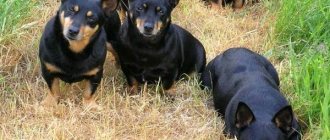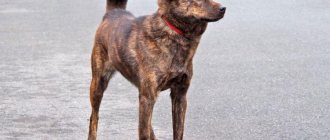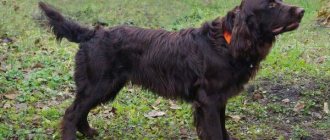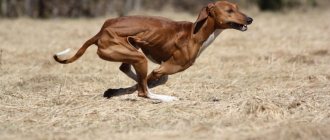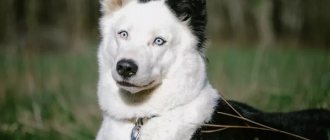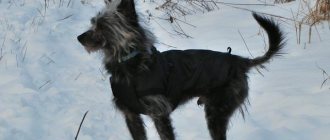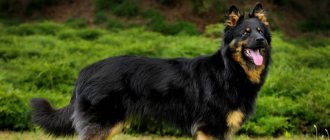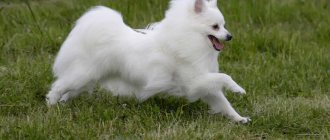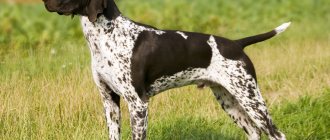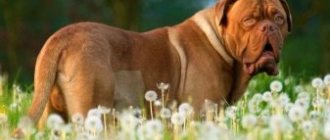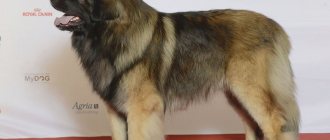a brief description of
- Other names: Lancashire Heeler, Ormskirk Heeler, Ormskirk Terrier, Ormskirk, Lancashire, heeler, heeler; Height: up to 30 cm at the withers;
- Weight: up to 6.00 kg;
- Color: black and tan, less often brown and tan;
- Wool: two-layer, thick, hard;
- Life expectancy: up to 15 years;
- Advantages of the breed: good watchman and shepherd. The dog takes part in hunting hare and fox, and also enthusiastically exterminates harmful rodents. They are affectionate and very gentle with children. An excellent companion with decent upbringing.
- Difficulties: lack of socialization leads the dog to irritation and aggression. Weak physical activity becomes a source of health problems. With a lack of care and communication with humans, dogs' self-esteem is significantly overestimated. He is often stubborn and self-willed.
- Price: $450.
Origin story
There are two main hypotheses for the appearance of Lancashire Heeler dogs on the planet.
A number of dog handlers consider the breed to be quite ancient, based on historical data and found drawings of dogs dating back to the 15th-17th centuries. The animals depicted in the engravings are very reminiscent of the modern Lancashire, not only in appearance, but also in the way the cattle are driven into the stall. Subsequently, the thread of the narrative about the existence of the breed is lost, and miniature herding dogs, after many years of oblivion, first appear at the Blackpool Dog Show only in 1982 - almost at the end of the last century.
According to the second version, the smallest shepherd dog owes its existence to cynologists who worked on creating the breed in the 70s of the last century. By crossing a Manchester Terrier with a Cardigan Welsh Corgi, the first Lancashire Heeler puppies were obtained, the price of which was beyond the reach of the average Briton.
Subsequently, the resulting litters were repeatedly mated with each other, with strict culling of individuals that did not correspond to ideas about the breed. And in 1981, the English Kennel Club adopted the first breed standard, which has undergone numerous changes to date. The International Cynological Association FCI, which has long refused to recognize heelers, only in 2021 granted Lancashire permission to compete in the international arena .
History of the breed
As is often the case with ancient breeds, it is difficult to determine their exact origins. One thing is certain - Lancashires appeared in England. Once upon a time, more than 200 years ago, a breed of Welsh Corgi was used to herd domestic animals from Wales to the northern and western parts of England.
In the Ormskirk area, whether by accident or design, one of the Welsh Corgis crossed with a black and brown Manchester Terrier. This is presumably how the Lancashire Heeler breed . By the way, in her homeland she is also called Ormskirk heeler or Ormskirk terrier.
In its area, this dog has become quite popular among livestock owners. She did an excellent job as a driver and shepherd. Gradually, the breed died out, until in 1960, dog enthusiast Gwen McIntosh began actively restoring the dog.
In 1978, she and other breeders formed the Lancashire Heeler Club and became its president. They developed an initial breed standard and registered. Recognition by the English Kennel Club followed in 1981. Gwen McIntosh continued to serve as president until her death in 1992.
In 2006, the breed was recognized as vulnerable local. This meant that annual registration numbers did not exceed 300. In 2016, the Fédération Cynologique Internationale added the breed to its list of provisionally accepted breeds.
Purpose of the breed
If we literally translate the phrase Lancashire Heeler, then the name of the breed sounds like “next on the heels . Miniature dogs really follow their owner's feet wherever he goes .
Dogs are very loyal to their owner and are able to simultaneously perform a number of functions in the house. Lancashires have proven themselves well in security activities , despite their original purpose as a shepherd. They were charged with driving flocks of sheep and cattle into stalls and driving them out to pasture.
Lancashires, endowed with lightning-fast reactions, are considered excellent hunters of the burrowing animal - the rabbit. Dogs also enthusiastically destroy domestic rodents and clean farmers' barns of rats and mice. Affectionate, highly trainable dogs have become excellent companions. They are used by the canistherapy program for the psychological rehabilitation of disabled people working in nursing homes.
Character
The smallest herding dogs with a strong body and short legs have agility, endurance and a friendly character . Lancashire tolerates winter well , working in any climate zone, with the exception of the Arctic and Antarctic, but only next to the owner , to whom the dogs are infinitely devoted.
The role of the security guard and protector of the house comes down to controlling the territory, inspecting the perimeter and keeping a vigil behind the front door. At the same time, all the inhabitants of the house are classified by the healer as wards who need to be guarded, be it cats, birds, exotic animals or children living with him under the same roof. They are all great friends for the dog. But dogs are stubborn , and some incidents often occur during training , which must be resolved persistently and patiently.
Lancashire has a special approach to children. The dog not only protects human offspring, but also becomes a magnificent gentle nanny , taking part in all children's games, expressing his irrepressible delight with a joyful bark. The dog is always ready for action - walks, hikes, games, jogging.
Choosing a puppy
Since the breed was bred by mixing the blood of a terrier with a shepherd, the character of the Lancashire Heeler contains more manifestations of the temperament of a shepherd than a terrier . The puppy is chosen based on general principles, focusing on the most active and inquisitive kids of the litter.
Since there are no breed nurseries in our country yet, you will have to travel abroad to get a puppy , but under no circumstances buy a pet at the poultry market. This is such a rare breed that the prospect of being deceived is too great.
Firstly, puppies must have documents - a birth certificate and a veterinary passport, which states the dates of mandatory vaccinations. Secondly, only in a nursery can you see the baby’s parents in order to know exactly what the pet will look like when it reaches adulthood. Thirdly, no one other than the breeder will provide complete information about the raising and education of a young Lancashire, the time of the next worming, and how to teach the pet to be swaddled at home during the upcoming quarantine period after vaccination.
Where to buy a puppy?
We have already said that the Lancashire Heeler is a rather rare breed in Russia. It is still quite difficult to find a nursery. You can contact the Flying Spitz kennel (Moscow region) or Ribessita (Estonia). The Faleser Hogland nursery, located in the city of Murom (Sovkhoznaya St., 11), receives good reviews. He specializes in breeding the Lancashire Heeler. Puppies are sold with all accompanying RKF documents, brand, veterinary passport. A purchase and sale agreement is drawn up. Those who need a Lancashire Heeler should know: the price of a puppy can vary from 45 to 60 thousand rubles.
Nicknames and names
The most important, quite complex and stressful process in the life of a dog owner is naming the pet . It is rare for a puppy to be given a nickname assigned by the breeder. In exceptional cases, when there is a record for puppies and the future owner is expecting the birth of a litter, the name with the specified letter is entered in the dog’s passport with the owner’s instructions. But such a phenomenon is extremely rare and is considered an exception.
Almost all pedigree dogs have two names - official and pet . The nickname with the prefix appears in the exhibition career, is included in diplomas, and the pet remains with the pet for its entire life, but this name is used exclusively in the domestic circle.
Care and maintenance
two-layer, dense, coarse coat requires minimal but regular weekly grooming . Once a week, the dog is well combed with a special brush. During the molting period, the pet is brushed twice a week .
After combing, clean the dog's ears and examine the eyes. Since the Lancashire Heeler is sometimes predisposed to ophthalmological diseases, a preventive eye examination is carried out at a veterinary clinic.
A mobile, active dog practically never has to trim its nails. And it is recommended to bathe a dog in exceptional cases - only if necessary , if the pet is very dirty.
Maintenance and care
It is very important that the healer feels equally comfortable both in the house and in the apartment. It is very active in a confined space, but does not require too large areas.
Long walks with his beloved owner are important for this dog, since he needs emotional contact with a person. During the walk, physical activity in the form of certain tasks and games is desirable.
The properties of wool are amazing, as it changes in different seasons. These dogs tolerate both heat and cold well - they do not require additional clothing.
They treat water differently. Some dogs get great pleasure, while others may have a very negative attitude towards water procedures.
Caring for the Lancashire Heeler is simple; difficulties sometimes arise with the coat, especially during molting, when the winter coat changes to summer. At this time, excess hair needs to be combed out quite often.
Health and heredity
, no more than three hundred representatives of the Lancashire Heeler breed are born in the world , whose puppies are mainly distributed throughout European countries. Maintaining statistics of hereditary diseases for only 4 thousand breed individuals is a simple and easy task, especially since dogs have excellent health and a strong immune system .
Healers mainly suffer from eye diseases that are inherited:
- districhiasis, or abnormal eyelash growth;
- Collie eye abnormality;
- primary lens luxation;
- prolapse of the eyeball or vitreous;
- cataracts that appear in old age;
- dry keratoconjunctivitis;
- persistent pupillary membrane and choroid of the lens;
- glaucoma.
Dysplasia is extremely rare, but patellar luxation is common and even young dogs are susceptible to it. Malocclusion is common . In old age, bitches need to be regularly seen by a veterinarian to avoid the occurrence of pyometra, and the temperature of an older dog should be regularly measured.
Seasonal preventive treatments for dogs against fleas, ticks and mosquitoes are very important. A bite from an infected parasite can cause serious illnesses that are incompatible with the life of the animal.
History of the Lancashire Heeler breed
The homeland of Lancashire Heelers is clearly stated in the breed standard - Great Britain.
Archaeological research carried out in the British Isles has made it possible to find multiple images of dogs similar in build and color to Lancashire dogs.
Examples of dogs similar in appearance to modern Lancashires were more often found in Lancashire, where these dogs got their nickname.
There is reason to believe that the blood of Welsh Heelers, Cardigan Welsh Corgis, Pembroke Welsh Corgis, Spitz and Manchester Terriers is mixed in the veins of Lancashires.
Targeted selection work with this breed of dogs was not carried out until the mid-1960s, when several enthusiasts, due to the threat of extinction, came up with the idea of restoring the Lancashire Heeler breed.
During the selection process, Manchester Terriers were crossed with Welsh Corgi Cardigans to produce puppies of a new breed that inherited many positive qualities (including herding) of their ancestors.
Photo 1. Lancashire heelers have a dense, well-built, muscular build
The resulting offspring were again crossed with each other, the “defective” specimens were sifted out, thanks to which it was possible to create a breed that is now commonly called the Lancashire Heeler.
In 1978, the first kennel club was created, uniting lovers of Lancashire heelers, and three years later the first breed standard was developed.
The English Kennel Club recognized the new breed in 1981, and the International Canine Federation recognized it another 35 years later (in May 2016).
The official participation of Lancashire heelers in authoritative exhibitions was recorded in 1984.
In 1988, a stud book of Lancashire Heelers was created, which included data on seven and a half hundred purebred representatives of this breed.
The baton of mass breeding of Lancashire heelers was actively picked up by breeders from Scandinavia, Belgium, Holland, and the USA.
In 1989, the Swedish Lancashire Heelers Club was registered, in 2003, a similar club was registered in Finland, and in 2010, Norway.
It is in these countries that the largest number of purebred Lancashires outside the UK is concentrated.
Lancashire Heelers are capable of producing from 2 to 4 puppies per year, which is why it is not possible to quickly increase the number of dogs of this breed.
Around the world, about three hundred Lancashire Heeler puppies are born each year. In total, there are just over 4 thousand individuals of Lancashire.
There are practically no purebred Lancashires in Russia, since Russian nurseries are not yet involved in breeding them.
Rare representatives of this breed are registered in Moscow and the Moscow region; they are counted in just a few.
Catering
Lancashire Heelers are very unpretentious to food . The diet of an adult dog can consist of natural products, where boiled meat . Puppies and adults are mainly fed premium or super-premium ready-made food for active dogs of small and medium breeds. When feeding a finished product, you should not exclude from the diet fresh vegetables and fruits given to the dog in season.
Important! The quality of drinking water is of great importance for the Lancashire Heeler.
Nutrition
It is necessary to pay attention to your pet's nutrition and physical fitness. Since the healer is quite active, his nutrition should fully satisfy his energy needs. For this reason, your pet's diet should include a sufficient amount of protein found in meat. It can be given to your dog boiled or raw. But recently, dog experts believe that boiled meat is preferable because it does not contain helminths and other unwanted microorganisms.
We must not forget about boiled vegetables and cereals mixed with meat-containing products. When feeding natural foods, you will need vitamin and mineral supplements, which your veterinarian will recommend.
Education and training
The puppy begins to be raised as soon as the dog crosses the threshold of a new home. Firstly, you need to immediately accustom your pet to using the toilet outside. After a short amount of time, the puppy begins to ask on its own.
Due to the specific nature of the breed, dogs tend to herd all the inhabitants of the house by pinching the legs with their front teeth . This will be weaned off gradually if the healer’s purpose is not in the field of cattle breeding.
Until the age of six months, the dog is methodically taught commands independently. But due to the stubborn and willful nature of Lancashire, from six months on it is better to resort to the services of a professional trainer .
For the purpose of socialization, the heeler is walked in crowded places on a leash. Only after the dog has learned a number of commands can the pet be allowed to run freely in deserted places, where there is no traffic.
Healers are smart enough to perceive and remember every command well . If the training process is carried out with a significant amount of love and affection, the dog becomes obliging and performs every exercise with precision.
Advantages and disadvantages
The great advantage of the breed is high level of get-together with all the inhabitants of the house. Dogs are given special respect in relationships with older children who have already learned how to control a dog. Lancashire is indispensable as a guard , suspicious of strangers, driving away uninvited guests from the territory entrusted to him with a loud, prolonged bark.
Dogs get offended if they are neglected . They don’t like it if communication is limited, and they begin to suffer, taking out their resentment on objects - eaten chair legs, house slippers, objects that accidentally ended up on the floor.
With sufficient communication coupled with quality upbringing, a puppy will grow into a wonderful companion, devoted and loving, even tender, not only towards children.
Wishes
We will be very grateful if, when copying any materials from our site, you indicate the original source. After all, all articles have their own authors or translators. We have collected them and made them available to you. Photos used with permission of their authors. And now we share all this wealth with you. Please respect our work. Thank you!
What does a Lancashire Heeler look like? The Lancashire Heeler should not be confused with the Swedish Vallhund, Welsh Corgi or other short-legged breeds or mixed breeds. The ideal height at the withers for males is considered to be 30 cm, for females - 25 cm. The standard does not specify the exact weight, it is approximately 3-8 kg, but it can be more. The Lancashire Heeler is an elongated dog with a deep and voluminous chest. The breed standard describes the Lancashire Heeler as a small but strong dog, so it should be quite powerful for its size. The front paws may be turned outward, but this should not affect movement. The hindquarters are strong and parallel both in static conditions and in movement. The back is straight and strong. Wedge-shaped head. The ears are triangular in shape, uncropped, fully erect or raised on cartilage. The bite is correct, scissor-shaped, all teeth are included. There are dogs with missing premolars. Information on the admission of partially toothed dogs for breeding needs clarification. It is known that in Finland dogs without P2 receive titles and have offspring.
The Lancashire Heeler can only be black and tan or brown and tan. According to the standard, the Lancashire Heeler may have a small white patch on the chest. The coat is short and close-lying. The amount of undercoat may vary depending on the time of year. Long-haired dogs are very rare and are excluded from breeding. The tail is also of a natural length; when excited, it can curl over the back, but should not form a ring.
Since the breed is still developing, there are quite a lot of different types of dogs among Lancashire Heelers, but a purebred Lancashire cannot be confused with anyone.
Reviews
Marianne:
Heelers have always looked like corgis to me, albeit smaller. When my husband brought the dog back from a business trip abroad, I realized that I was not entirely right. This is a completely different dog. No worse and no better, but my favorite. He even protects me from my husband if he starts swearing. Lancashires have many innate abilities which they demonstrate on a daily basis.
Peter:
The main advantages of the breed are strength, flexibility and endurance. My dog is the most cheerful creature I have ever met in my life. When I'm having a hard time, my faithful friend is able to understand the mood in a matter of minutes.
Lily:
The most interesting thing is that each dog treats water individually. All my littermates just love to swim, but my dog doesn’t even go near the water. And he shows such disgust on his face that I can only laugh.
If you have materials on the process of raising a Lancashire Heeler and you have sketches of the character of this rare breed of dog, we will be immensely grateful for posting the information on our website. We invite all people who care about the breed to communicate. Comments and reviews can be left at the bottom of the article. We look forward to your responses.
Share
Leave a review
